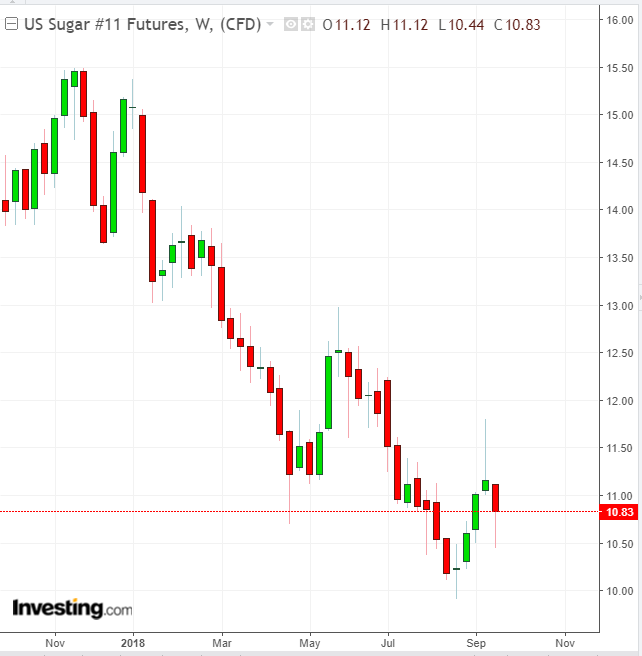Sugar and arabica coffee seem ready to share the bullish spotlight with cocoa. This potential fourth quarter rally would come as exhaustion in their price downside occurs just before year-end festivities across the globe raise demand for such soft commodities.
“Low prices cure low prices and I think we have seen the lows of the year for sugar and arabica,” said James Cordier, founding broker and analyst for soft commodities at Optionsellers.com in Tampa, Florida. He added:
“Cocoa has had a nice rally over the last couple of months and we don’t see it going up a whole lot, but we do see sugar and coffee being good performers between now and the fourth quarter.”

Cocoa has been the number 1 performing commodity of 2018, having gained 16 percent year-to-date.
In the case of sugar, the front-month October contract in New York gained more than 9 percent after hitting 10-year lows, below 10 cents a pound a month ago, helped by charts indicating extreme oversold conditions.
Sugar Near 2-Month High

While Wednesday’s settlement of 10.76 marks the first positive finish in four sessions for October sugar, the contract has also seen four successive weeks of gains since August 19. The peak was a two-month high of 11.80, achieved last week.
Investing.com's technical outlook has mixed calls on October sugar, with the strongest Level 3 Fibonacci resistance indicated at 10.92—meaning the contract could rise another one to two cents. Mike Seery of Seery Futures in Plainfield, Illinois, said October sugar was trading above the 20-day moving average but under the 100-day MA, resulting in the mixed trend.
“It looks to me that a ‘V’ bottom has been formed as prices bottomed out on August 22nd at $9.91,” Seery wrote in a commentary, adding that “all of the poor fundamental news has already been reflected into the price”.
Shawn Hackett of Hackett Financial Advisors in Boca Raton, Florida, said dramatic reductions in EU sugar beet production due to drought had also sparked the rebound in the sweetener’s prices from August lows. Reduced acres and large use of sugar for ethanol-making provided additional support, he said.
But Hackett also noted the strong rally of the past month was also a red flag “as normally, prices retest lows after an initial major low.” He urged sugar bulls to be cautious of a possible setback in coming weeks.
Cordier was more optimistic, saying he expected March sugar, which some traders preferred as a benchmark over October, to reach above 13 cents over the next three months from Wednesday’s settlement at 11.64. “I think if we rally to 13 cents on March, that will be a pretty good performance, considering both the supply and demand that will be coming out of India,” he said.
Festivities Ensure Demand
The fourth quarter is usually the heaviest period for sugar consumption in India, the second largest producer of the sweetener after Brazil. A string of religious and other festivals over the next two months result in huge demand for sweets and other delicacies in mostly-Hindu India, beginning with October’s “Navarathiri,” the nine-night celebration of the goddess triumvirate Durga, Saraswati, Lakshmi, and culminating with late November’s “Diwali,” or the festival of lights.
In the western world, meanwhile, the celebrations of Thanksgiving, Hanukkah, Christmas and the New Year holiday also lead to heightened demand for sugar during this period, as the eating and giving of chocolates and baked delicacies become a main event. Premium coffee chains, including Starbucks (NASDAQ:SBUX), Retail Food Group’s (AX:RFG) Gloria Jean’s and Whitbread’s (LON:WTB) Costa are known to have some of their highest sales in the fourth quarter.
For coffee, Cordier says he expects the March arabica contract to hit $1.15 a lb by the year end, versus Wednesday’s settlement of $1.0005.

Investing.com's daily technical outlook, however, calls for a “Strong Sell” on the front-month December arabica contract, which last traded at $0.967 a lb. No immediate buy targets have been set.
Crop Conditions and Brazilian Real Favor Coffee
Other than the apparent bottoming out in coffee prices and year-end retail demand, arabica could see steadily lower output from here through 2020, said Cordier.
“What’s happening in coffee now is that many farmers in Brazil, Colombia, Honduras, and Guatemala can’t afford fertilizers or do pruning of tree branches and other maintenance that will produce good crops.”
Cordier added: “The question is ‘Are you gonna walk up that mountain and pick up coffee beans when you know you’re going to lose money on your crop? No?’ Then we’re going to have lower production in the coming year and two.”
Hackett said the potential for a rally in Brazil’s real could also boost coffee near term. “Coffee has been pressured by the collapse in the Brazilian real and crashing emerging market currencies in general. With Brazil elections slated for October, the prospects for a turnaround in the real’s fate to a more bullish mode could set record short speculators running for the exits.”
